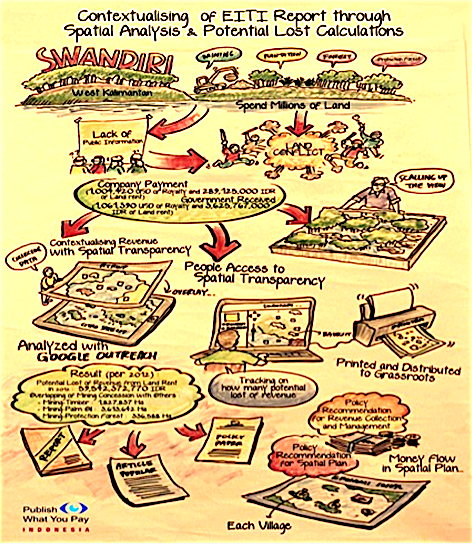 The Importance of Project by Project Disclosure
The Importance of Project by Project Disclosure
Indonesia’s vast natural resources wealth includes oil, gas, bauxite, silver, and gold. Indonesia is the world’s second largest tin producer, and one of the top five producers of copper and nickel. The extractives sector plays an outsized role in the Indonesian economy: in 2014, oil, gas, and minerals were responsible for a third of all government revenue, and accounted for more than 50 percent of all non-tax revenue.
Indonesia, an EITI implementing country, has produced three reports since it became an implementing country in 2009. EITI reports were valuable to civil society organizations because of the level of detail found in the data. EITI Indonesia requires oil and gas companies to report the payments they make to the government that emerge from each of their production sharing contracts.
US-listed oil and gas companies operating in Indonesia that report through the EITI include BP, Chevron, CNOOC, ConocoPhillips, ExxonMobil, Petro China, and Total. While EITI Indonesia does not yet explicitly require project-level disclosure, in the mining sector, the reality is that many mining companies operate only a single project in a particular region, making their payment disclosures de facto project-level. Civil society organizations, residents, and local governments have been lobbying for EITI in Indonesia to fully implement the 2013 standard, which requires all companies to report their payments by project.
As stated in the law, Indonesia’s resource revenue is primarily collected by the central government, and then apredetermined percentage is redistributed to lower levels of government. It is intended tomake sure that citizens living near the extraction projects reap some of benefits. Local governments receive 15 percent of oil revenue generated by localprojects, 30 percent of gas revenue, and 80 percent of mineral royalties. Of the 15 percent of oil revenue that is to beredistributed to lower levels of government, 3 percent goes to the producing province, 6percent goes to the producing district, and 6 percent goes to the districts adjacent to theproducing district (as compensation for pollution and other adverse consequences ofresource extraction).
Figure 1: Oil and Gas Revenue Sharing Distribution

The American Petroleum Institute proposes that companies report at the first tier below the central government. In the Indonesian context, this would mean that companies would report how much they paid in each province. Reporting at this level would prevent producer district residents from knowing how much revenue was generated from the projects within their district. Without this information, they would be unable to calculate if they received the 6 percent they are owed by the central government.
Ensuring that local governments and communities are properly compensated for the oil, gas, and mining activities, is just one way that project-level data will be used in Indonesia.
Publish What You Pay – Indonesia and its allies have already made use of EITI Indonesia’s limited payment disclosure data:
PWYP Indonesia, in collaboration with the Swandiri Institute, used GIS technology and EITI data on mining licenses to compare the territory on which mining and palm oil companies were legally permitted to operate, with where these companies were actually operating. The research identified that there were much overlapping concession between mining, logging, timber and palm oil and also with the forest area. Many are also operating outside the licensed territory – a transgression estimated to have cost Indonesia’s West Kalimantan province over $1.5 million in lost land rent.
The research findings were sent to the Corruption Eradication Commission, and played an important role in convincing the Commission to initiate a campaign to improve the quality of governance in Indonesia’s mining sector. See the full report here
PWYP-Indonesia has also worked with SOMASI (a local partner) on collecting project-level payment data and other information relating to mining operations underway in tworesource-rich districts, West Lombok and West Sumbawa. It was intended to assess how effectively the district governments had utilized the natural resource wealth to advance human development. Some data was derived from Indonesia’s EITI reports, while other information, such as corporate’s commitment for local communities and environment namely corporate social responsibility payment data, was obtained from other sources. The data enabled us to piece together a comprehensive picture of the revenue collected from extractives companies, and assess whether the West Lombok and West Sumbawa districts had achieved better socio-economic development outcomes than their peers. Since it was not, we recommended to local government authorities a number of modifications to revenue management, including additional spending on the provision of public services. For further information see here
Finally , PWYP-Indonesia and partners have conducted several successful public education programs, especially in Papua province. We developed and circulated newsletters to civil society networks, journalists, students, and local government leaders containing information about project-level payment data, the names of companies with production sharing contracts in the area, and informationabout transfers of revenue from the national to local governments. Moreover, we conducted local television and radio programming that brought policy makers, local civil society organizations, and company representatives to talk about EITI Indonesia, andanswer audience questions. These initiatives have raised public awareness of theavailability of payment information and its impact on improving the governance of our natural resources. Further information can be found here
While we have made great progress using EITI data, our advocacy has been further enhanced when project-level payment data has been available. The implementation of Section 1504 reporting requirements is crucial to ensuring that all project-level data becomes available in Indonesia. This will fill the gaps that currently exist in the EITI data.